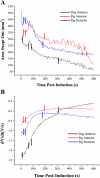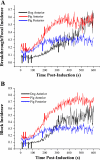Evolution of activation patterns during long-duration ventricular fibrillation in pigs
- PMID: 22180655
- PMCID: PMC3322740
- DOI: 10.1152/ajpheart.00419.2011
Evolution of activation patterns during long-duration ventricular fibrillation in pigs
Abstract
Quantitative analysis has demonstrated five temporal stages of activation during the first 10 min of ventricular fibrillation (VF) in dogs. To determine whether these stages exist in another species, we applied the same analysis to the first 10 min of VF recorded in vivo from two 504-electrode arrays, one each on left anterior and posterior ventricular epicardium in six anesthetized pigs. The following descriptors were continuously quantified: 1) number of wavefronts, 2) wavefront fractionations, 3) wavefront collisions, 4) repeatability, 5) multiplicity index, 6) wavefront conduction velocity, 7) activation rate, 8) mean area activated by the wavefronts, 9) negative peak rate of voltage change, 10) incidence of breakthrough/foci, 11) incidence of block, and 12) incidence of reentry. Cluster analysis of these descriptors divided VF into four stages (stages i-iv). The values of most descriptors increased during stage i (1-22 s after VF induction), changed quickly to values indicating greater organization during stage ii (23-39 s), decreased steadily during stage iii (40-187 s), and remained relatively unchanged during stage iv (188-600 s). The epicardium still activated during stage iv instead of becoming silent as in dogs. In conclusion, during the first 10 min, VF activation can be divided into four stages in pigs instead of five stages as in dogs. Following a 16-s period during the first minute of VF when activation became more organized, all parameters exhibited progressive decreased organization. Further studies are warranted to determine whether these changes, particularly the increased organization of stage ii, have clinical consequences, such as alteration in defibrillation efficacy.
Figures










Similar articles
-
Evolution of activation patterns during long-duration ventricular fibrillation in dogs.Am J Physiol Heart Circ Physiol. 2004 Mar;286(3):H1193-200. doi: 10.1152/ajpheart.00773.2003. Am J Physiol Heart Circ Physiol. 2004. PMID: 14766680
-
Evolution of the organization of epicardial activation patterns during ventricular fibrillation.J Cardiovasc Electrophysiol. 1998 Dec;9(12):1291-1304. doi: 10.1111/j.1540-8167.1998.tb00105.x. J Cardiovasc Electrophysiol. 1998. PMID: 9869529
-
Estimated global transmural distribution of activation rate and conduction block during porcine and canine ventricular fibrillation.Circ Res. 2004 Apr 2;94(6):836-42. doi: 10.1161/01.RES.0000120860.01645.17. Epub 2004 Feb 5. Circ Res. 2004. PMID: 14764451
-
Our search for the porcine mother rotor.Ann Noninvasive Electrocardiol. 2005 Oct;10(4 Suppl):7-15. doi: 10.1111/j.1542-474X.2005.00071.x. Ann Noninvasive Electrocardiol. 2005. PMID: 16274411 Free PMC article. Review.
-
Mechanisms of VF maintenance: wandering wavelets, mother rotors, or foci.Heart Rhythm. 2009 Mar;6(3):405-15. doi: 10.1016/j.hrthm.2008.11.005. Epub 2008 Nov 8. Heart Rhythm. 2009. PMID: 19251220 Free PMC article. Review.
Cited by
-
A classification scheme for ventricular arrhythmias using wavelets analysis.Med Biol Eng Comput. 2013 Feb;51(1-2):153-64. doi: 10.1007/s11517-012-0980-y. Epub 2012 Nov 7. Med Biol Eng Comput. 2013. PMID: 23132525
-
Insights Into the Spatiotemporal Patterns of Complexity of Ventricular Fibrillation by Multilead Analysis of Body Surface Potential Maps.Front Physiol. 2020 Sep 23;11:554838. doi: 10.3389/fphys.2020.554838. eCollection 2020. Front Physiol. 2020. PMID: 33071814 Free PMC article.
-
Endocardial focal activation originating from Purkinje fibers plays a role in the maintenance of long duration ventricular fibrillation.Croat Med J. 2014 Apr;55(2):121-7. doi: 10.3325/cmj.2014.55.121. Croat Med J. 2014. PMID: 24778098 Free PMC article.
-
Effects of combination of sotalol and verapamil on initiation, maintenance, and termination of ventricular fibrillation in swine hearts.Cardiovasc Ther. 2018 Jun;36(3):e12326. doi: 10.1111/1755-5922.12326. Epub 2018 Mar 25. Cardiovasc Ther. 2018. PMID: 29485248 Free PMC article.
-
Endocardial Activation Drives Activation Patterns During Long-Duration Ventricular Fibrillation and Defibrillation.Circ Arrhythm Electrophysiol. 2017 Dec;10(12):e005562. doi: 10.1161/CIRCEP.117.005562. Circ Arrhythm Electrophysiol. 2017. PMID: 29247031 Free PMC article.
References
-
- Antzelevitch C, Sicouri S, Litovsky SH, Lukas A, Krishnan SC, Di Diego JM, Gintant GA, Liu DW. Heterogeneity within the ventricular wall. Electrophysiology and pharmacology of epicardial, endocardial, and M cells. Circ Res 69: 1427–1449, 1991 - PubMed
-
- Bagdonas AA, Stuckey JH, Piera J, Amer NS, Hoffman BF. Effects of ischemia and hypoxia on the specialized conducting system of the canine heart. Am Heart J 61: 206–218, 1961 - PubMed
-
- Carmeliet E. Action potential duration, rate of stimulation, and intracellular sodium. J Cardiovasc Electrophysiol 17, Suppl 1: S2–S7, 2006 - PubMed
-
- Cobb LA, Fahrenbruch CE, Olsufka M, Copass MK. Changing incidence of out-of-hospital ventricular fibrillation, 1980–2000. JAMA 288: 3008–3013, 2002 - PubMed
-
- Cordeiro JM, Mazza M, Goodrow R, Ulahannan N, Antzelevitch C, Di Diego JM. Functionally distinct sodium channels in ventricular epicardial and endocardial cells contribute to a greater sensitivity of the epicardium to electrical depression. Am J Physiol Heart Circ Physiol 295: H154–H162, 2008 - PMC - PubMed
Publication types
MeSH terms
Grants and funding
LinkOut - more resources
Full Text Sources

